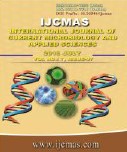


 National Academy of Agricultural Sciences (NAAS)
National Academy of Agricultural Sciences (NAAS)

|
PRINT ISSN : 2319-7692
Online ISSN : 2319-7706 Issues : 12 per year Publisher : Excellent Publishers Email : editorijcmas@gmail.com / submit@ijcmas.com Editor-in-chief: Dr.M.Prakash Index Copernicus ICV 2018: 95.39 NAAS RATING 2020: 5.38 |
Rhizoctonia solani Kühn [teleomorph :Thanatephorus cucumeris (Frank) Donk] is the most destructive and widely distributed soil borne pathogenic fungus causing black scurf of Potato. Cultural and morphological variability was studied in eleven potato isolates of R. solani collected from different potato growing areas including Haryana, Punjab, Uttarakhand, Rajasthan and Maharashtra etc. Based on the radial colony growth rate, all the isolates were categorised into 3 groups as slow, medium and fast growing. Majority of isolates showed slow colony growth rate. Hyphal width in all the isolates ranged between 6 to 10.5 μm. Most of the isolates produced appressed or raised and pale yellow to very pale brown, mycelium with varied patterns of sclerotial formation. Majority of isolates had sclerotia that aggregated at the centre of the colony. Isolates produced brown to dark brown sclerotia which were either present in the form of concentric ring at the centre or periphery or scattered throughout the colony. Studies on cultural and morphological characterization of R. solani isolates showed that isolates were highly variable both in mycelial and sclerotial parameters, with no consistent characters related geographic origin.
 |
 |
 |
 |
 |